transmission fluid FORD F-600 2022 Owners Manual
[x] Cancel search | Manufacturer: FORD, Model Year: 2022, Model line: F-600, Model: FORD F-600 2022Pages: 740, PDF Size: 12.6 MB
Page 7 of 740
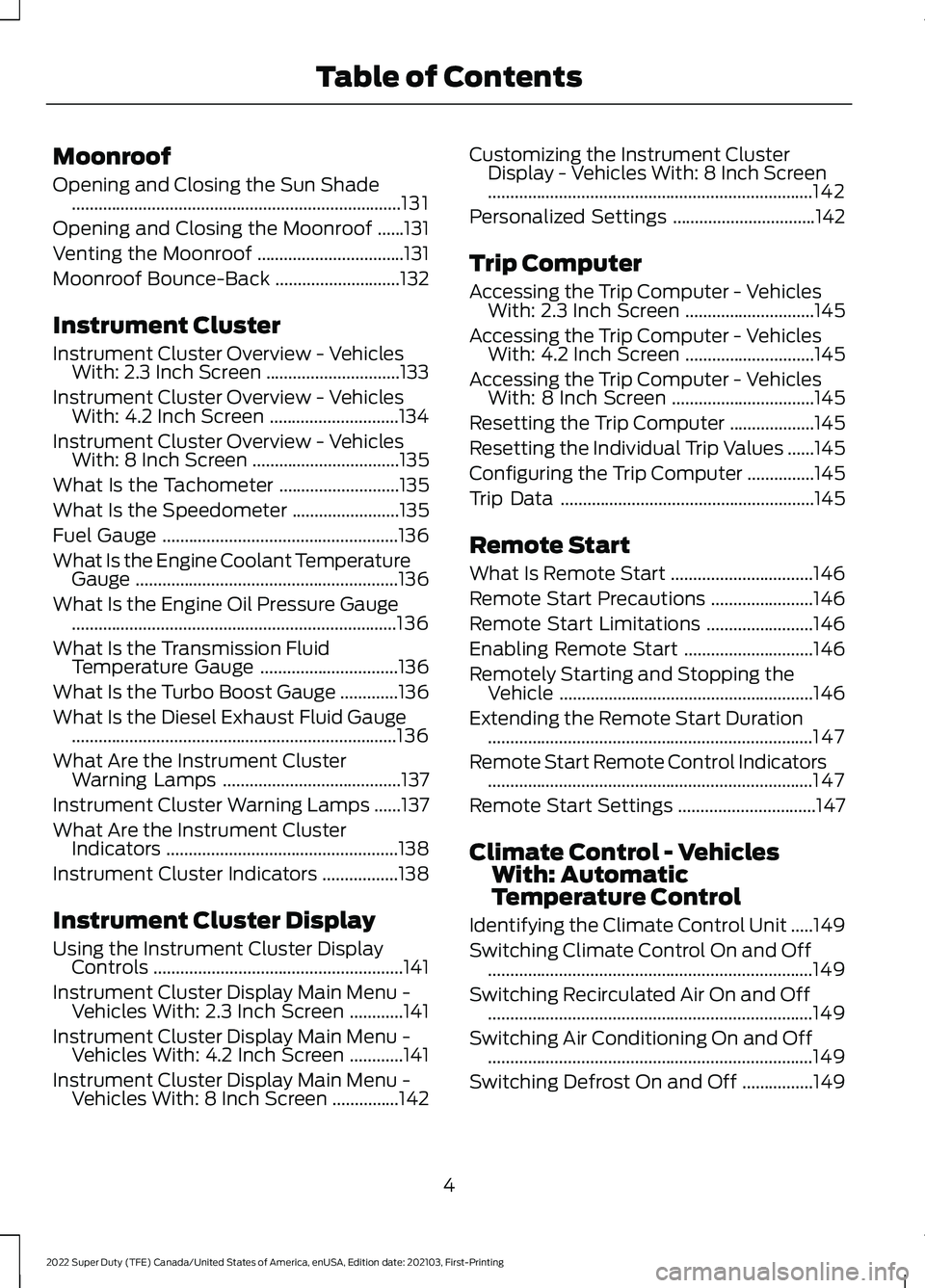
Moonroof
Opening and Closing the Sun Shade
........................................................................\
..131
Opening and Closing the Moonroof ......
131
Venting the Moonroof .................................
131
Moonroof Bounce-Back ............................
132
Instrument Cluster
Instrument Cluster Overview - Vehicles With: 2.3 Inch Screen ..............................
133
Instrument Cluster Overview - Vehicles With: 4.2 Inch Screen .............................
134
Instrument Cluster Overview - Vehicles With: 8 Inch Screen .................................
135
What Is the Tachometer ...........................
135
What Is the Speedometer ........................
135
Fuel Gauge .....................................................
136
What Is the Engine Coolant Temperature Gauge ...........................................................
136
What Is the Engine Oil Pressure Gauge ........................................................................\
.
136
What Is the Transmission Fluid Temperature Gauge ...............................
136
What Is the Turbo Boost Gauge .............
136
What Is the Diesel Exhaust Fluid Gauge ........................................................................\
.
136
What Are the Instrument Cluster Warning Lamps ........................................
137
Instrument Cluster Warning Lamps ......
137
What Are the Instrument Cluster Indicators ....................................................
138
Instrument Cluster Indicators .................
138
Instrument Cluster Display
Using the Instrument Cluster Display Controls ........................................................
141
Instrument Cluster Display Main Menu - Vehicles With: 2.3 Inch Screen ............
141
Instrument Cluster Display Main Menu - Vehicles With: 4.2 Inch Screen ............
141
Instrument Cluster Display Main Menu - Vehicles With: 8 Inch Screen ...............
142Customizing the Instrument Cluster
Display - Vehicles With: 8 Inch Screen
........................................................................\
.
142
Personalized Settings ................................
142
Trip Computer
Accessing the Trip Computer - Vehicles With: 2.3 Inch Screen .............................
145
Accessing the Trip Computer - Vehicles With: 4.2 Inch Screen .............................
145
Accessing the Trip Computer - Vehicles With: 8 Inch Screen ................................
145
Resetting the Trip Computer ...................
145
Resetting the Individual Trip Values ......
145
Configuring the Trip Computer ...............
145
Trip Data .........................................................
145
Remote Start
What Is Remote Start ................................
146
Remote Start Precautions .......................
146
Remote Start Limitations ........................
146
Enabling Remote Start .............................
146
Remotely Starting and Stopping the Vehicle .........................................................
146
Extending the Remote Start Duration ........................................................................\
.
147
Remote Start Remote Control Indicators ........................................................................\
.
147
Remote Start Settings ...............................
147
Climate Control - Vehicles With: Automatic
Temperature Control
Identifying the Climate Control Unit .....
149
Switching Climate Control On and Off ........................................................................\
.
149
Switching Recirculated Air On and Off ........................................................................\
.
149
Switching Air Conditioning On and Off ........................................................................\
.
149
Switching Defrost On and Off ................
149
4
2022 Super Duty (TFE) Canada/United States of America, enUSA, Edition date: 202103, First-Printing Table of Contents
Page 10 of 740
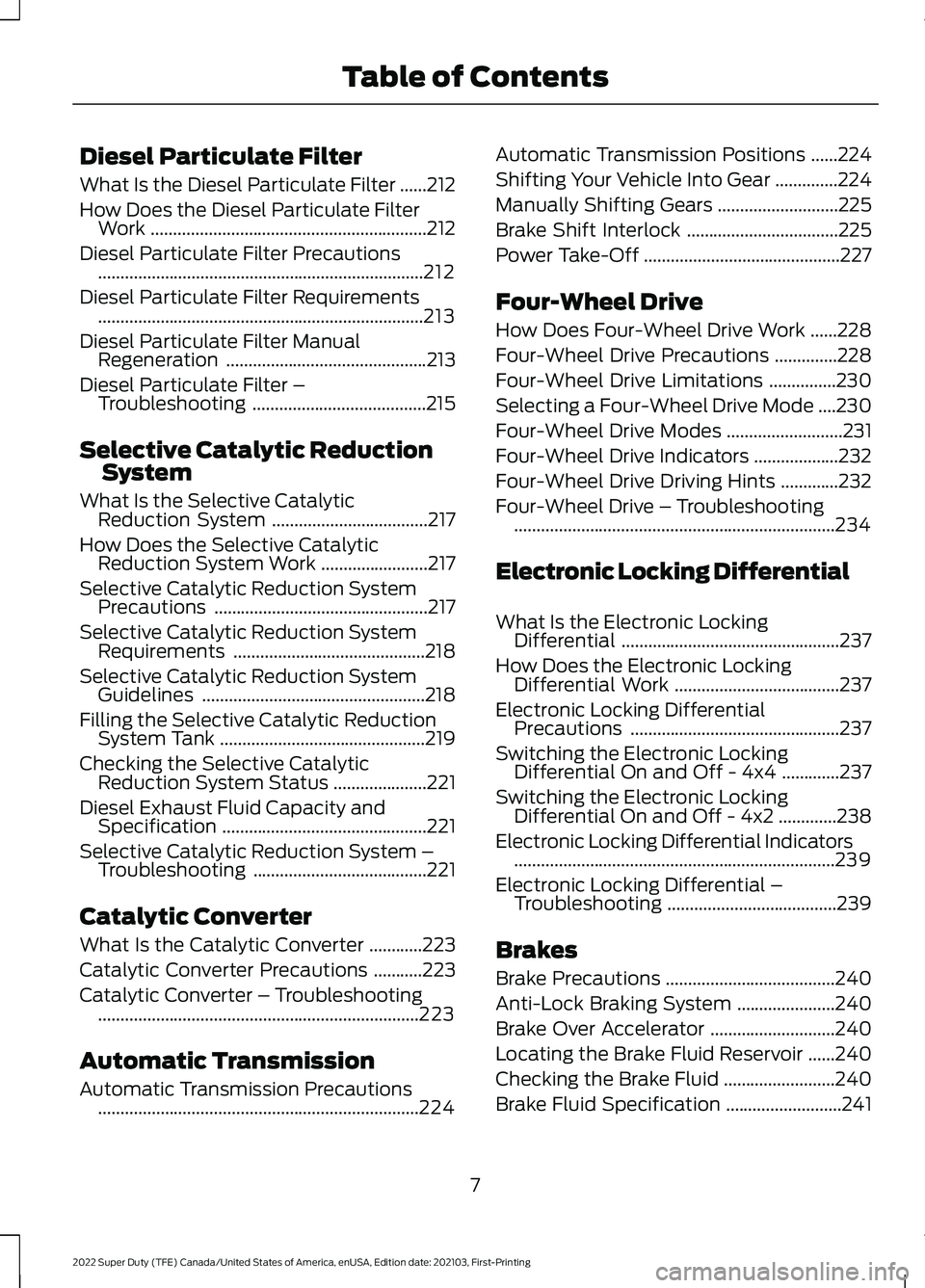
Diesel Particulate Filter
What Is the Diesel Particulate Filter
......212
How Does the Diesel Particulate Filter Work ..............................................................
212
Diesel Particulate Filter Precautions ........................................................................\
.
212
Diesel Particulate Filter Requirements ........................................................................\
.
213
Diesel Particulate Filter Manual Regeneration .............................................
213
Diesel Particulate Filter – Troubleshooting .......................................
215
Selective Catalytic Reduction System
What Is the Selective Catalytic Reduction System ...................................
217
How Does the Selective Catalytic Reduction System Work ........................
217
Selective Catalytic Reduction System Precautions ................................................
217
Selective Catalytic Reduction System Requirements ...........................................
218
Selective Catalytic Reduction System Guidelines ..................................................
218
Filling the Selective Catalytic Reduction System Tank ..............................................
219
Checking the Selective Catalytic Reduction System Status .....................
221
Diesel Exhaust Fluid Capacity and Specification ..............................................
221
Selective Catalytic Reduction System – Troubleshooting .......................................
221
Catalytic Converter
What Is the Catalytic Converter ............
223
Catalytic Converter Precautions ...........
223
Catalytic Converter – Troubleshooting ........................................................................\
223
Automatic Transmission
Automatic Transmission Precautions ........................................................................\
224 Automatic Transmission Positions
......
224
Shifting Your Vehicle Into Gear ..............
224
Manually Shifting Gears ...........................
225
Brake Shift Interlock ..................................
225
Power Take-Off ............................................
227
Four-Wheel Drive
How Does Four-Wheel Drive Work ......
228
Four-Wheel Drive Precautions ..............
228
Four-Wheel Drive Limitations ...............
230
Selecting a Four-Wheel Drive Mode ....
230
Four-Wheel Drive Modes ..........................
231
Four-Wheel Drive Indicators ...................
232
Four-Wheel Drive Driving Hints .............
232
Four-Wheel Drive – Troubleshooting ........................................................................\
234
Electronic Locking Differential
What Is the Electronic Locking Differential .................................................
237
How Does the Electronic Locking Differential Work .....................................
237
Electronic Locking Differential Precautions ...............................................
237
Switching the Electronic Locking Differential On and Off - 4x4 .............
237
Switching the Electronic Locking Differential On and Off - 4x2 .............
238
Electronic Locking Differential Indicators ........................................................................\
239
Electronic Locking Differential – Troubleshooting ......................................
239
Brakes
Brake Precautions ......................................
240
Anti-Lock Braking System ......................
240
Brake Over Accelerator ............................
240
Locating the Brake Fluid Reservoir ......
240
Checking the Brake Fluid .........................
240
Brake Fluid Specification ..........................
241
7
2022 Super Duty (TFE) Canada/United States of America, enUSA, Edition date: 202103, First-Printing Table of Contents
Page 16 of 740

Inspecting the Wheel Valve Stems
......446
Tire Rotation ................................................
446
Tire Pressure Monitoring System
What Is the Tire Pressure Monitoring System .......................................................
448
Tire Pressure Monitoring System Overview ...................................................
448
Tire Pressure Monitoring System Precautions ..............................................
449
Tire Pressure Monitoring System Limitations ................................................
449
Viewing the Tire Pressures .....................
450
Resetting Tire Pressure Monitoring System .......................................................
450
Tire Pressure Monitoring System – Troubleshooting ......................................
453
Changing a Road Wheel
Changing a Flat Tire ..................................
455
Wheel Nuts ...................................................
465
Capacities and Specifications
Engine Specifications - 6.2L ...................
467
Engine Specifications - 6.7L Diesel ......
467
Engine Specifications - 7.3L ...................
468
Motorcraft Parts - 6.2L ............................
469
Motorcraft Parts - 6.7L Diesel .................
471
Motorcraft Parts - 7.3L ..............................
472
Engine Oil Capacity and Specification - 6.2L ...............................................................
473
Engine Oil Capacity and Specification - 6.7L Diesel .................................................
474
Engine Oil Capacity and Specification - 7.3L ................................................................
477
Cooling System Capacity and Specification - 6.2L ................................
479
Cooling System Capacity and Specification - 6.7L Diesel ..................
480Cooling System Capacity and
Specification - 7.3L ................................
480
Fuel Tank Capacity - Diesel .....................
481
Fuel Tank Capacity - Gasoline ...............
482
Air Conditioning System Capacity and Specification - 6.2L ...............................
483
Air Conditioning System Capacity and Specification - 6.7L Diesel ..................
484
Air Conditioning System Capacity and Specification - 7.3L ................................
485
Washer Fluid Specification .....................
485
Diesel Exhaust Fluid Capacity and Specification ............................................
486
Automatic Transmission Fluid Capacity and Specification - Diesel ...................
487
Automatic Transmission Fluid Capacity and Specification - Gasoline ..............
487
Brake Fluid Specification ........................
489
Transfer Case Fluid Capacity and Specification ...........................................
490
Front Axle Fluid Capacity and Specification ...........................................
490
Rear Axle Fluid Capacity and Specification - Diesel .............................
491
Rear Axle Fluid Capacity and Specification - Gasoline ......................
493
Hydraulic Power Steering Fluid Capacity and Specification ...................................
496
Vehicle Identification
Vehicle Identification Number ...............
497
Connected Vehicle - Vehicles With: SYNC 3
What Is a Connected Vehicle ................
498
Connected Vehicle Requirements .......
498
Connected Vehicle Limitations .............
498
Connecting the Vehicle to a Mobile Network .....................................................
498
Connecting the Vehicle to a Wi-Fi Network .....................................................
498
Connected Vehicle – Troubleshooting - Vehicles With: Modem .........................
499
13
2022 Super Duty (TFE) Canada/United States of America, enUSA, Edition date: 202103, First-Printing Table of Contents
Page 136 of 740
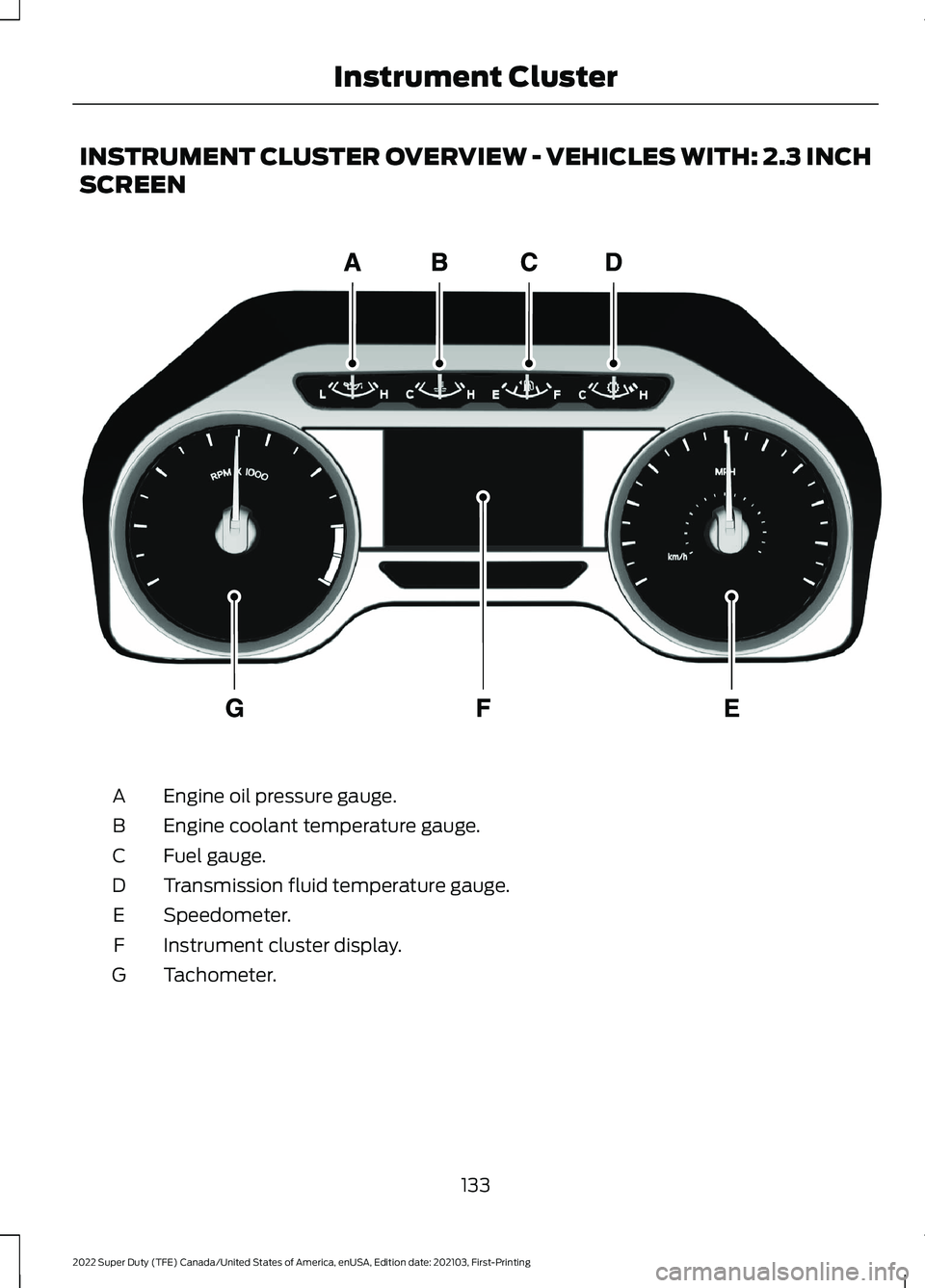
INSTRUMENT CLUSTER OVERVIEW - VEHICLES WITH: 2.3 INCH
SCREEN
Engine oil pressure gauge.
A
Engine coolant temperature gauge.
B
Fuel gauge.
C
Transmission fluid temperature gauge.
D
Speedometer.
E
Instrument cluster display.
F
Tachometer.
G
133
2022 Super Duty (TFE) Canada/United States of America, enUSA, Edition date: 202103, First-Printing Instrument ClusterE219638
Page 137 of 740

INSTRUMENT CLUSTER OVERVIEW - VEHICLES WITH: 4.2 INCH
SCREEN
Engine oil pressure gauge.
A
Engine coolant temperature gauge.
B
Fuel gauge.
C
Transmission fluid temperature gauge.
D
Speedometer.
E
Instrument cluster display.
F
Tachometer.
G
134
2022 Super Duty (TFE) Canada/United States of America, enUSA, Edition date: 202103, First-Printing Instrument ClusterE219638
Page 138 of 740
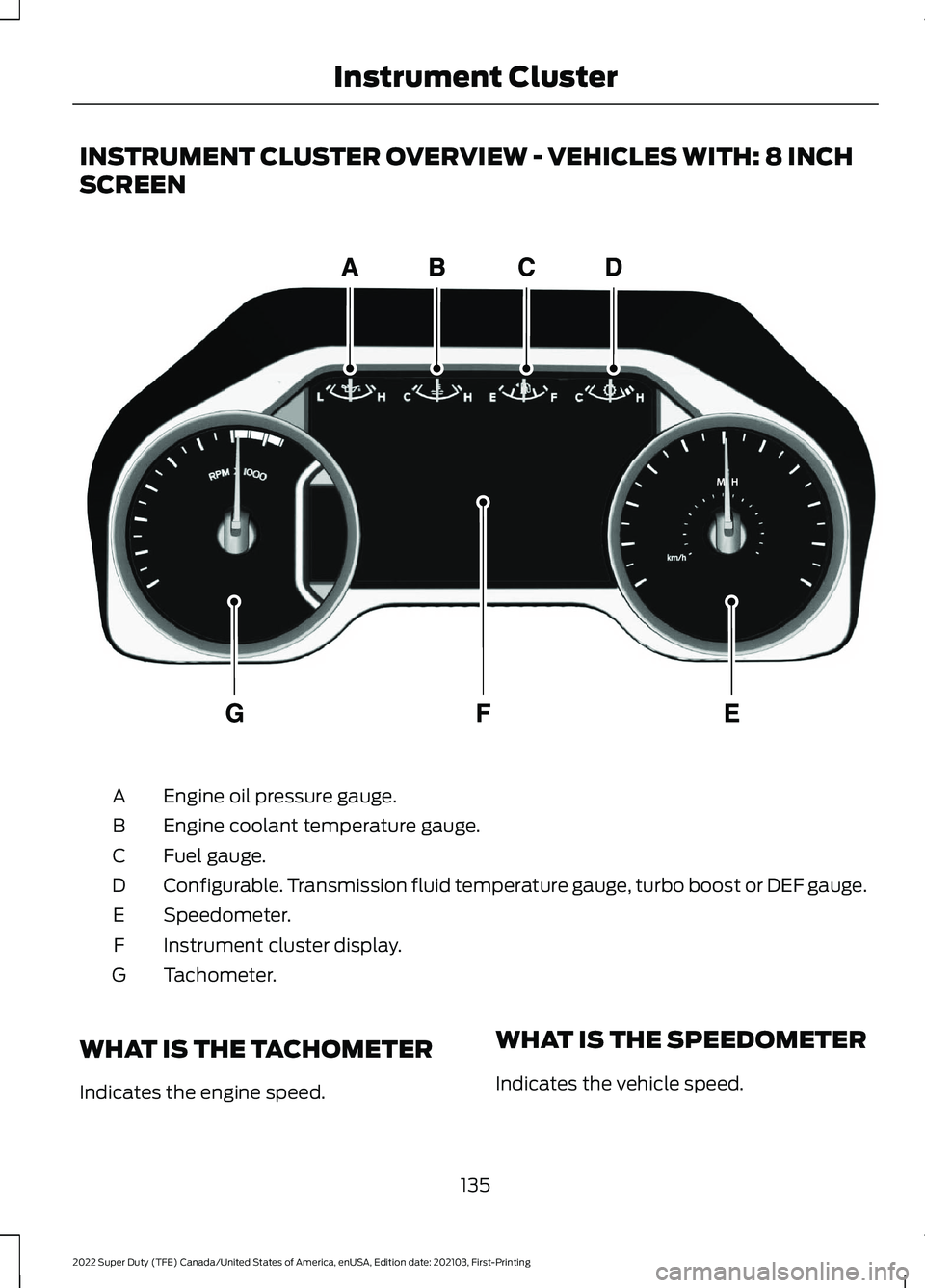
INSTRUMENT CLUSTER OVERVIEW - VEHICLES WITH: 8 INCH
SCREEN
Engine oil pressure gauge.
A
Engine coolant temperature gauge.
B
Fuel gauge.
C
Configurable. Transmission fluid temperature gauge, turbo boost or DEF gauge.
D
Speedometer.
E
Instrument cluster display.
F
Tachometer.
G
WHAT IS THE TACHOMETER
Indicates the engine speed. WHAT IS THE SPEEDOMETER
Indicates the vehicle speed.
135
2022 Super Duty (TFE) Canada/United States of America, enUSA, Edition date: 202103, First-Printing Instrument ClusterE219651
Page 139 of 740
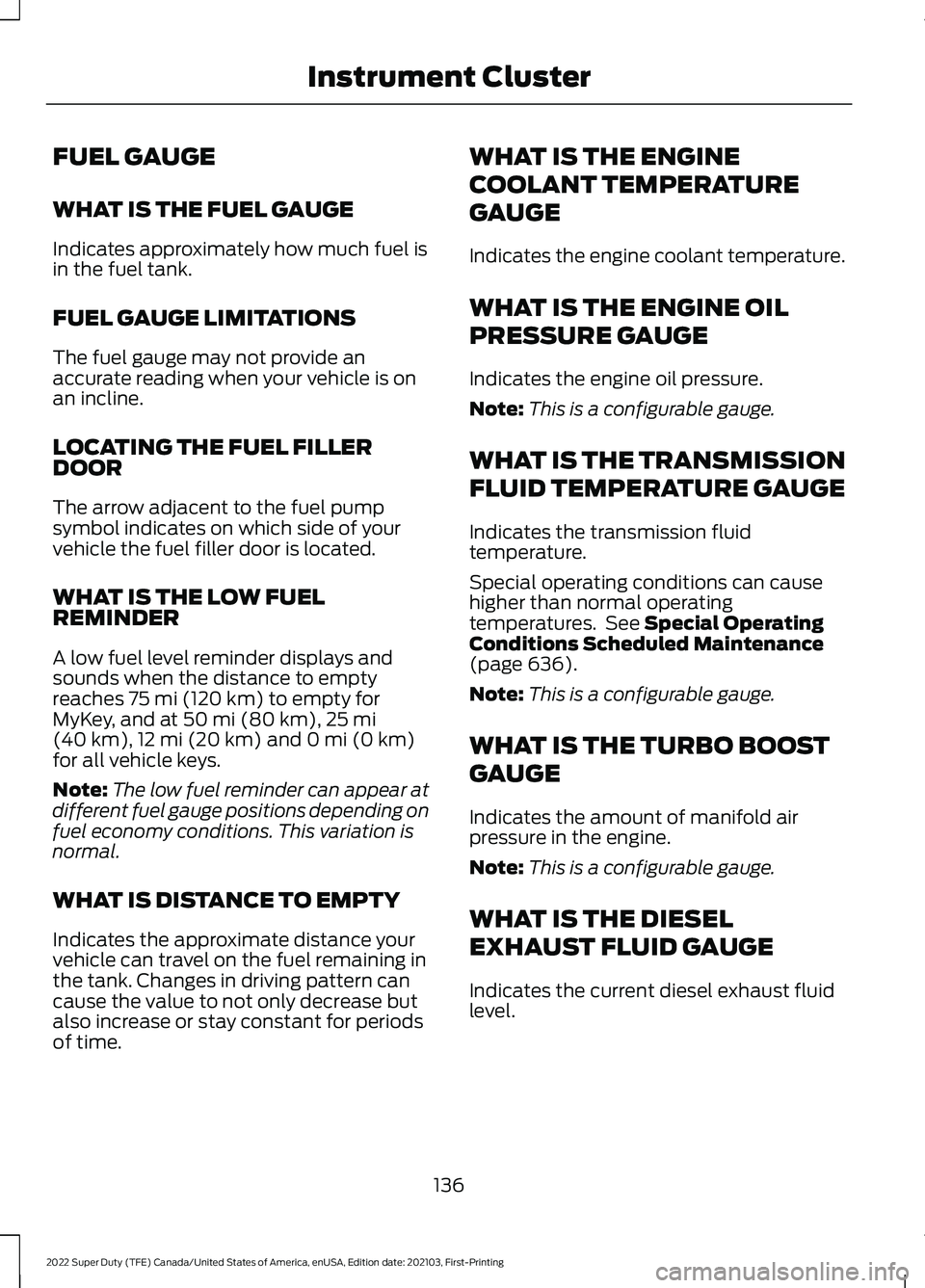
FUEL GAUGE
WHAT IS THE FUEL GAUGE
Indicates approximately how much fuel is
in the fuel tank.
FUEL GAUGE LIMITATIONS
The fuel gauge may not provide an
accurate reading when your vehicle is on
an incline.
LOCATING THE FUEL FILLER
DOOR
The arrow adjacent to the fuel pump
symbol indicates on which side of your
vehicle the fuel filler door is located.
WHAT IS THE LOW FUEL
REMINDER
A low fuel level reminder displays and
sounds when the distance to empty
reaches 75 mi (120 km) to empty for
MyKey, and at 50 mi (80 km), 25 mi
(40 km), 12 mi (20 km) and 0 mi (0 km)
for all vehicle keys.
Note: The low fuel reminder can appear at
different fuel gauge positions depending on
fuel economy conditions. This variation is
normal.
WHAT IS DISTANCE TO EMPTY
Indicates the approximate distance your
vehicle can travel on the fuel remaining in
the tank. Changes in driving pattern can
cause the value to not only decrease but
also increase or stay constant for periods
of time. WHAT IS THE ENGINE
COOLANT TEMPERATURE
GAUGE
Indicates the engine coolant temperature.
WHAT IS THE ENGINE OIL
PRESSURE GAUGE
Indicates the engine oil pressure.
Note:
This is a configurable gauge.
WHAT IS THE TRANSMISSION
FLUID TEMPERATURE GAUGE
Indicates the transmission fluid
temperature.
Special operating conditions can cause
higher than normal operating
temperatures. See
Special Operating
Conditions Scheduled Maintenance
(page
636).
Note: This is a configurable gauge.
WHAT IS THE TURBO BOOST
GAUGE
Indicates the amount of manifold air
pressure in the engine.
Note: This is a configurable gauge.
WHAT IS THE DIESEL
EXHAUST FLUID GAUGE
Indicates the current diesel exhaust fluid
level.
136
2022 Super Duty (TFE) Canada/United States of America, enUSA, Edition date: 202103, First-Printing Instrument Cluster
Page 230 of 740

POWER TAKE-OFF (IF EQUIPPED)
HOW DOES THE POWER TAKE-
OFF WORK
Auxiliary equipment called power take-off,
or PTO, is often added to the engine or
transmission to operate utility equipment.
Examples include a wheel-lift for tow
trucks, cranes, tools for construction or tire
service, and pumping fluids. PTO
applications draw auxiliary horsepower
from the powertrain, often while the
vehicle is stationary. In this condition, there
is limited cooling air flow through the
radiator and around the vehicle that
normally occurs when a vehicle is moving.
The aftermarket PTO system installer,
having the most knowledge of the final
application, is responsible for determining
whether additional chassis heat protection
or powertrain cooling is required, and
alerting the user to the safe and proper
operation.
Note: Use of auxiliary equipment that
exceeds the maximum Power Take-Off
(PTO) load specified in our Truck Body
Builders Layout Book can adversely affect
the performance of the powertrain system.
Refer to the Body Builders Layout Book for
instructions about the appropriate
installation of additional equipment.
For additional information, visit
www .f or dbb a s. c om/home .
WHAT IS THE SPLIT SHAFT
CAPABILITY
Split shaft capability is when the output
gear connects directly with the engine to
power your power takeoff (PTO), anytime
the engine is running. This feature is approved as a stationary
mobile power source, within the limits and
operating guidelines detailed in our Truck
Body Builders Layout Book. For additional
information, visit
www .f or dbb a s. c om/home .
227
2022 Super Duty (TFE) Canada/United States of America, enUSA, Edition date: 202103, First-Printing Automatic Transmission
Page 243 of 740
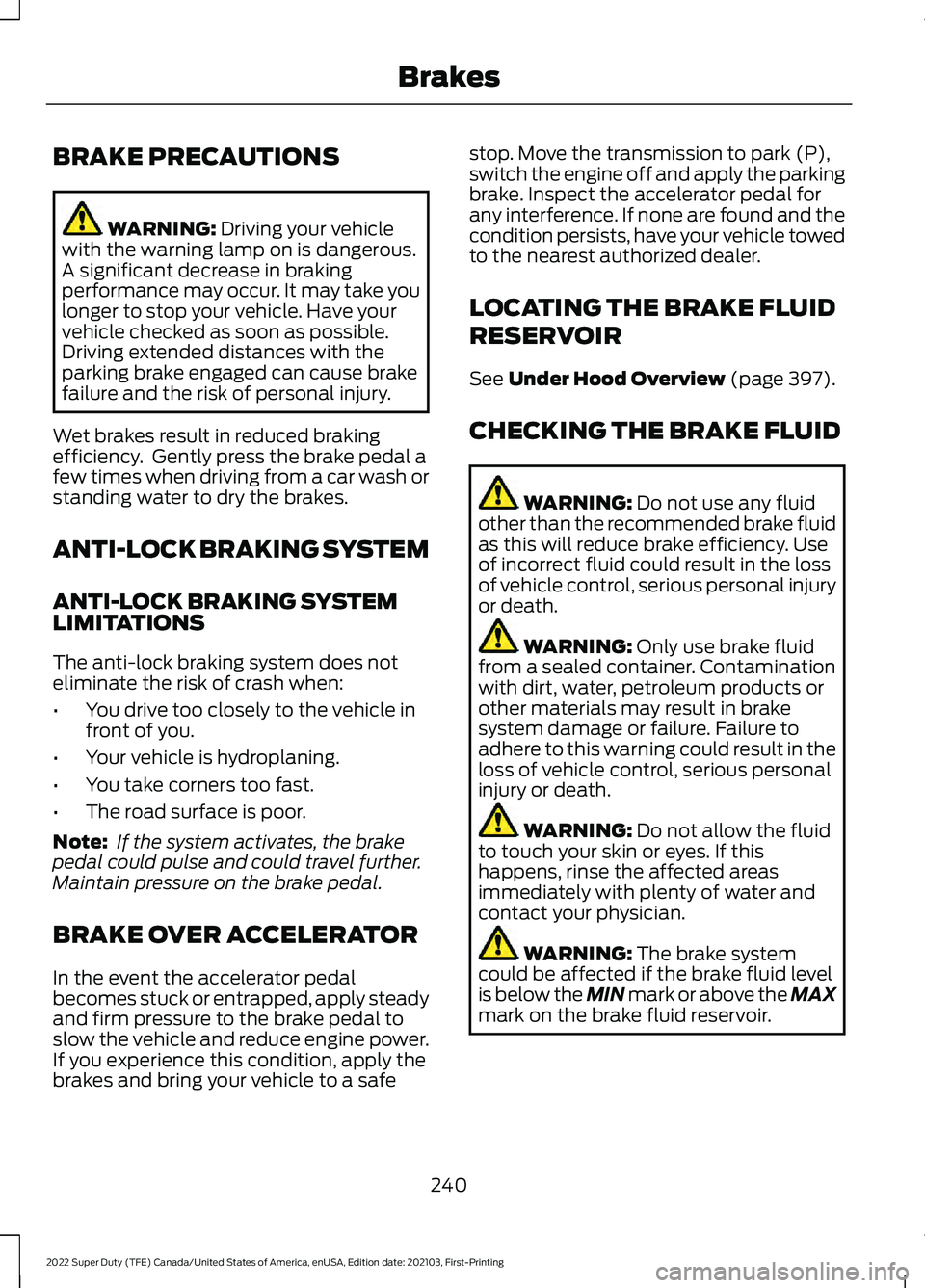
BRAKE PRECAUTIONS
WARNING: Driving your vehicle
with the warning lamp on is dangerous.
A significant decrease in braking
performance may occur. It may take you
longer to stop your vehicle. Have your
vehicle checked as soon as possible.
Driving extended distances with the
parking brake engaged can cause brake
failure and the risk of personal injury.
Wet brakes result in reduced braking
efficiency. Gently press the brake pedal a
few times when driving from a car wash or
standing water to dry the brakes.
ANTI-LOCK BRAKING SYSTEM
ANTI-LOCK BRAKING SYSTEM
LIMITATIONS
The anti-lock braking system does not
eliminate the risk of crash when:
• You drive too closely to the vehicle in
front of you.
• Your vehicle is hydroplaning.
• You take corners too fast.
• The road surface is poor.
Note: If the system activates, the brake
pedal could pulse and could travel further.
Maintain pressure on the brake pedal.
BRAKE OVER ACCELERATOR
In the event the accelerator pedal
becomes stuck or entrapped, apply steady
and firm pressure to the brake pedal to
slow the vehicle and reduce engine power.
If you experience this condition, apply the
brakes and bring your vehicle to a safe stop. Move the transmission to park (P),
switch the engine off and apply the parking
brake. Inspect the accelerator pedal for
any interference. If none are found and the
condition persists, have your vehicle towed
to the nearest authorized dealer.
LOCATING THE BRAKE FLUID
RESERVOIR
See
Under Hood Overview (page 397).
CHECKING THE BRAKE FLUID WARNING:
Do not use any fluid
other than the recommended brake fluid
as this will reduce brake efficiency. Use
of incorrect fluid could result in the loss
of vehicle control, serious personal injury
or death. WARNING:
Only use brake fluid
from a sealed container. Contamination
with dirt, water, petroleum products or
other materials may result in brake
system damage or failure. Failure to
adhere to this warning could result in the
loss of vehicle control, serious personal
injury or death. WARNING:
Do not allow the fluid
to touch your skin or eyes. If this
happens, rinse the affected areas
immediately with plenty of water and
contact your physician. WARNING:
The brake system
could be affected if the brake fluid level
is below the MIN mark or above the MAX
mark on the brake fluid reservoir.
240
2022 Super Duty (TFE) Canada/United States of America, enUSA, Edition date: 202103, First-Printing Brakes
Page 380 of 740
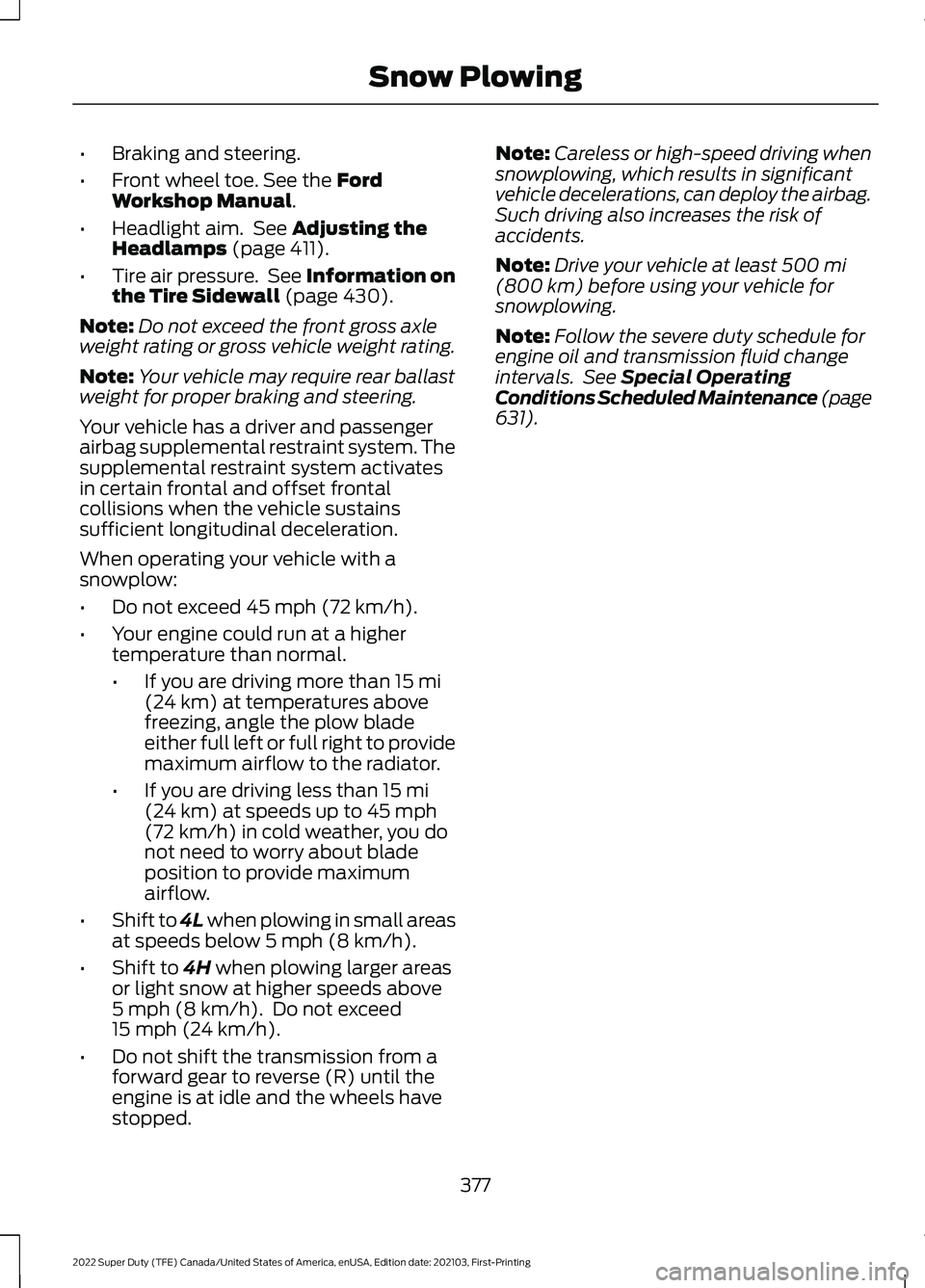
•
Braking and steering.
• Front wheel toe. See the Ford
Workshop Manual.
• Headlight aim. See
Adjusting the
Headlamps (page 411).
• Tire air pressure. See Information on
the Tire Sidewall
(page 430).
Note: Do not exceed the front gross axle
weight rating or gross vehicle weight rating.
Note: Your vehicle may require rear ballast
weight for proper braking and steering.
Your vehicle has a driver and passenger
airbag supplemental restraint system. The
supplemental restraint system activates
in certain frontal and offset frontal
collisions when the vehicle sustains
sufficient longitudinal deceleration.
When operating your vehicle with a
snowplow:
• Do not exceed
45 mph (72 km/h).
• Your engine could run at a higher
temperature than normal.
•If you are driving more than
15 mi
(24 km) at temperatures above
freezing, angle the plow blade
either full left or full right to provide
maximum airflow to the radiator.
• If you are driving less than
15 mi
(24 km) at speeds up to 45 mph
(72 km/h) in cold weather, you do
not need to worry about blade
position to provide maximum
airflow.
• Shift to 4L when plowing in small areas
at speeds below
5 mph (8 km/h).
• Shift to
4H when plowing larger areas
or light snow at higher speeds above
5 mph (8 km/h)
. Do not exceed
15 mph (24 km/h).
• Do not shift the transmission from a
forward gear to reverse (R) until the
engine is at idle and the wheels have
stopped. Note:
Careless or high-speed driving when
snowplowing, which results in significant
vehicle decelerations, can deploy the airbag.
Such driving also increases the risk of
accidents.
Note: Drive your vehicle at least
500 mi
(800 km) before using your vehicle for
snowplowing.
Note: Follow the severe duty schedule for
engine oil and transmission fluid change
intervals. See
Special Operating
Conditions Scheduled Maintenance (page
631
).
377
2022 Super Duty (TFE) Canada/United States of America, enUSA, Edition date: 202103, First-Printing Snow Plowing